You need 30-minute light therapy sessions for winter SAD because this specific duration allows your brain to properly reset its chemical balance and circadian rhythm. When you're exposed to bright light (typically 10,000 lux) for this timeframe, it helps reduce melatonin production and boost serotonin levels that are disrupted during darker winter months. Your body requires this consistent daily exposure, ideally in the morning between 6:00 and 9:00 a.m., to effectively regulate your mood and sleep patterns. While 30 minutes is standard, some people might need longer sessions depending on the light intensity and their individual response to treatment. Understanding these biological mechanisms can help you maximize your therapy's effectiveness.
The Science Behind Light Exposure
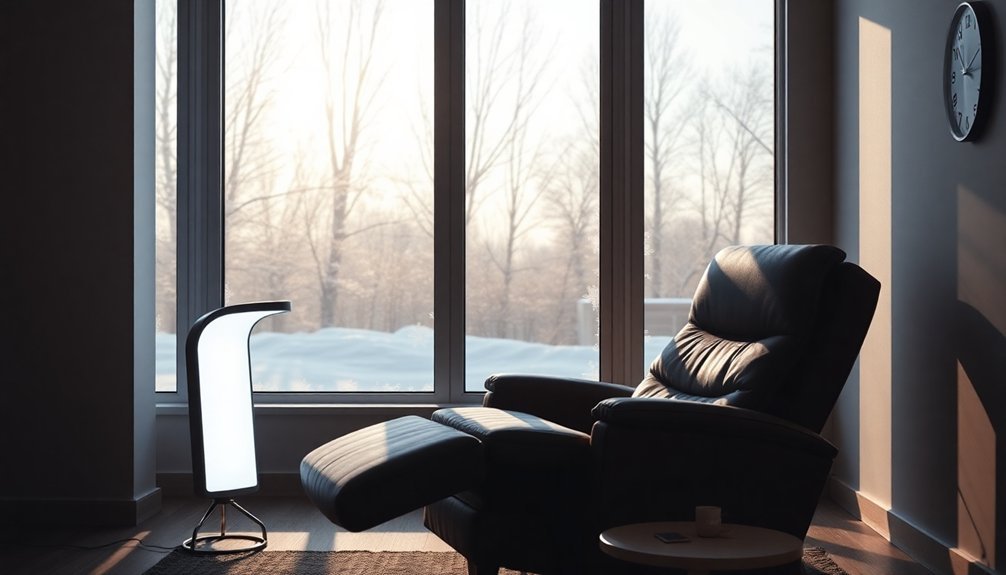
In light of recent research, understanding how light therapy affects your circadian rhythm is essential for treating Seasonal Affective Disorder (SAD). Your body's internal clock responds differently to light exposure depending on when you receive it – morning light advances your circadian phase, while evening light delays it. Since people with SAD often have phase-delayed circadian rhythms, morning light therapy helps correct this imbalance.
When you expose yourself to bright light therapy in the morning, you're directly influencing your body's natural wake-up mechanisms. You'll need 30 minutes of exposure at 10,000 lux, which is equivalent to longer sessions at lower light intensities. The timing is vital – it's most effective immediately after waking and before 8 AM. Clinical studies show that morning light treatments result in 37% lower depression ratings compared to pretreatment levels.
This early morning exposure helps regulate both your circadian rhythms and serotonin levels.
While both morning and evening light therapy can improve depressive symptoms, morning sessions are preferred because they align with your natural wake-up time. Your response to light therapy isn't affected by factors like age, gender, or time of year, making it a versatile treatment option.
For the best results, you'll need to maintain consistent daily sessions, including weekends.
Winter's Impact on Brain Chemistry
Your brain undergoes significant chemical shifts during winter months as decreased sunlight disrupts the delicate balance of serotonin and melatonin production.
You'll experience lower serotonin levels when exposed to less natural light, while your brain simultaneously produces more melatonin, the hormone that makes you sleepy.
These chemical changes directly affect your mood regulation system, creating the perfect storm for seasonal affective disorder symptoms as your brain struggles to maintain its summer chemistry during darker days. Research shows that people living in northern latitudes tend to experience more severe SAD symptoms due to shorter winter days.
Serotonin During Dark Days
The human brain kicks off a complex chemical cascade during winter months, substantially altering serotonin levels and disrupting normal mood regulation. You'll notice these changes most prominently when daylight hours shrink, as your brain responds to reduced sunlight exposure by adjusting its serotonin production.
During winter's darker days, your brain increases SERT (serotonin transporter) levels, which actively remove more serotonin from your system. SAD sufferers typically show 5% higher SERT levels compared to those unaffected by the condition. This process, combined with vitamin D deficiency, creates a double impact on your brain chemistry.
Your hypothalamus, which controls your internal clock, struggles to maintain normal daily rhythms as serotonin decreases and melatonin increases.
You'll likely experience these chemical changes through various symptoms. Your cognitive function may decline, and you might feel more anxious, sad, or withdrawn. It's not just "winter blues" – your brain's actually working with less of the neurotransmitter it needs for mood regulation.
The reduced serotonin activity can leave you feeling lethargic and emotionally low, similar to clinical depression. Your body's internal circadian rhythm becomes disrupted, making it harder to maintain regular sleep-wake patterns and energy levels throughout the day.
Light-Triggered Brain Changes
Winter's dramatic shift in daylight patterns sets off a complex chain of light-triggered changes within your brain. When you're exposed to fewer hours of sunlight, your brain's chemistry begins to alter in significant ways.
Your serotonin levels drop, which directly impacts your mood regulation, while your melatonin production increases, making you feel more tired and prone to oversleeping. People who experience these changes often develop appetite for carbohydrates.
The reduced sunlight exposure affects how certain molecules in your brain function, disrupting the delicate balance that maintains healthy serotonin levels. You'll notice these changes most intensely during the winter months, especially if you live farther from the equator. Your brain's emotional control centers become particularly vulnerable to these seasonal light fluctuations.
That's why light therapy has become a vital treatment option. When you sit in front of a bright light box (10,000 lux) for 30-45 minutes daily, you're helping to reset your brain's chemistry. This targeted exposure compensates for the natural sunlight you're missing, and you'll typically start feeling improvements within one to two weeks.
Regular light therapy sessions can effectively maintain these positive changes and prevent your symptoms from returning.
Optimal Duration for Light Treatment
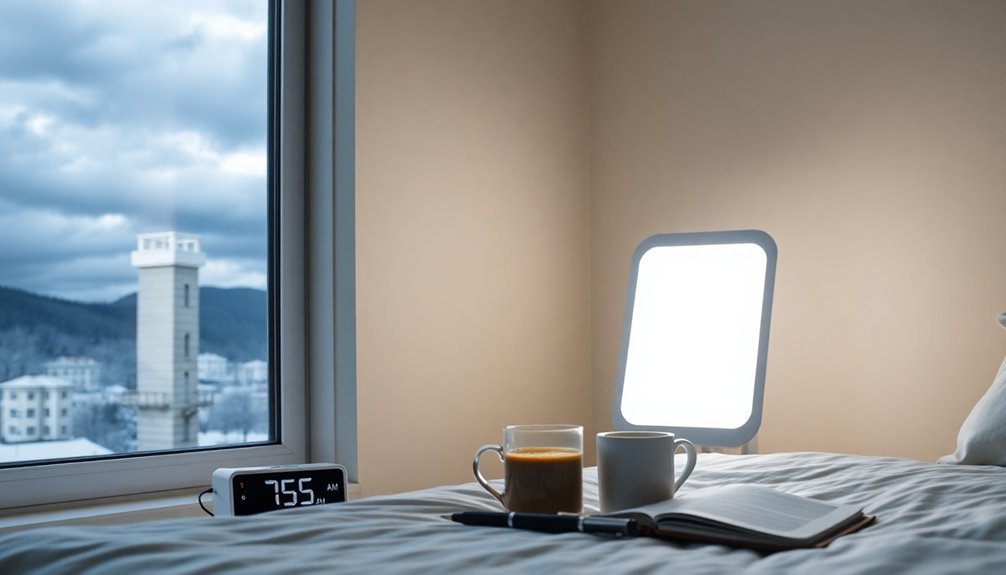
You'll get the best results from your light therapy by consistently using it for 30 minutes each morning between 6:00 and 9:00 a.m.
Your symptoms should start improving within a few days, but if you don't see changes after two weeks, you might need to increase your sessions to 60 minutes.
While evening sessions can help, research shows that morning light exposure is more effective at regulating your brain chemistry and relieving SAD symptoms.
Light Intensity and Time
Successful light therapy for SAD depends heavily on two critical factors: light intensity and exposure duration. At the standard recommended intensity of 10,000 lux, you'll need 30-45 minutes of daily exposure in the morning for best results.
If you're using a lower-intensity light box at 2,500 lux, you'll need to extend your sessions to 1-2 hours. For medium-intensity devices at 5,000 lux, plan on 45-60 minutes of daily exposure.
Whatever intensity you choose, you'll need to maintain consistency by using the light box at the same time each day. You can adjust your exposure time based on how you respond to the therapy, but don't expect immediate results – improvements typically appear within a few days to two weeks of regular use.
When selecting a light box, make certain it includes a UV filter for eye protection. If you're considering light therapy, you should know that morning sessions generally produce better results than evening treatments.
While different devices like LED lights and dawn simulators are available, traditional light boxes at 10,000 lux remain the most effective option for treating winter-pattern SAD.
Morning Vs Evening Exposure
The timing of light therapy sessions can substantially impact your treatment success. Research consistently shows that morning light exposure produces higher remission rates and more effective antidepressant effects compared to evening sessions.
If you're starting light therapy, you'll want to schedule your sessions within the first hour after waking up for the best results.
While evening light therapy can still be beneficial, with some studies reporting a 70% response rate, it doesn't provide the same circadian phase advantages as morning exposure. Morning sessions help advance your circadian rhythm, which is particularly important if you're dealing with moderate SAD symptoms. You'll get the most benefit from consistent 20-30 minute sessions in the morning.
If your schedule makes morning sessions challenging, don't give up on light therapy altogether. Evening sessions can still help, though they may cause a phase delay in your circadian rhythm. Remember that individual responses vary, so you'll need to work with your healthcare provider to determine the most effective timing for your specific situation.
What's most important is maintaining daily consistency with your chosen treatment schedule.
Treatment Schedule Guidelines
Most SAD light therapy protocols recommend daily 30-minute sessions with a 10,000-lux light box positioned at arm's length from your face.
If you don't notice improvements within 10-14 days, you can increase your exposure time to 60 minutes. You'll need to maintain this routine consistently from fall through spring for the best results.
If you're using a lower-intensity light box, you'll need to adjust your exposure time accordingly. A 2,500-lux device requires 1-2 hours of exposure, while a 5,000-lux light box needs 45-60 minutes.
During your sessions, you can read or eat, but don't fall asleep. Make sure you're not staring directly at the lights, as this can cause discomfort.
You should expect to see improvements in your symptoms within a few days to two weeks of starting treatment. It's fine to take breaks if your symptoms are improving, but you'll want to resume treatment if they return.
While light therapy is highly effective for SAD, you might need medical supervision if you have eye conditions. Remember to maintain a regular sleep schedule during your treatment period to maximize the benefits.
Morning Sessions Versus Evening Therapy
Light therapy's effectiveness heavily depends on the timing of your sessions, with research strongly favoring morning treatments over evening exposure. You'll get the best results by using your light box immediately after waking up, as morning light creates a circadian phase advance that's proven more antidepressant than evening exposure.
When you use light therapy in the morning, you're working with your body's natural rhythm. The morning exposure helps regulate your melatonin levels and stabilizes your mood throughout the day.
You'll want to maintain a consistent 30-minute session at 10,000 lux each morning for maximum benefits. If you're combining light therapy with other treatments like antidepressants or psychotherapy, morning sessions still remain the recommended choice.
Evening light therapy isn't recommended because it can actually worsen your SAD symptoms. It causes a circadian phase delay that may disrupt your sleep patterns and interfere with your mood regulation.
If you can't accommodate morning sessions, don't switch to evening therapy – instead, talk to your healthcare provider about alternative treatment options. They can help you develop a personalized treatment plan that works with your schedule while effectively managing your SAD symptoms.
Circadian Rhythm Reset Requirements
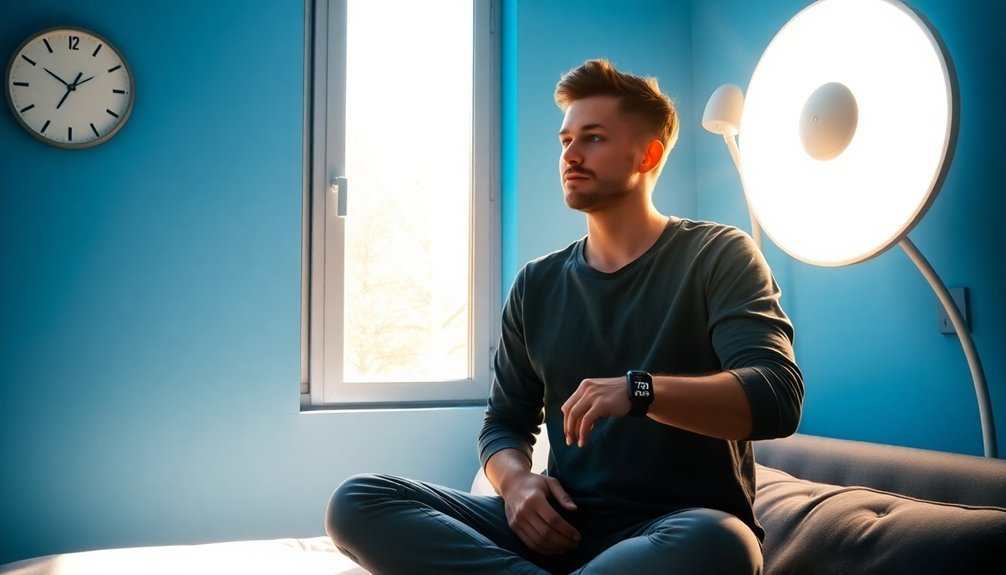
Winter's shorter days can substantially disrupt your internal clock, leading to misaligned circadian rhythms and potential SAD symptoms. When you're not getting enough natural daylight, your body produces more melatonin than usual, which can trigger depression and throw off your sleep-wake cycle.
You'll need consistent exposure to bright light, especially in the morning, to reset your internal clock and maintain healthy circadian rhythms.
To effectively reset your circadian rhythm during winter months, you'll need:
- Daily exposure to 10,000 lux light therapy for 30 minutes, preferably in the morning
- A consistent sleep schedule that aligns with your light therapy sessions
- Reduced evening screen time to prevent disrupting your body's natural melatonin production
Starting light therapy 2-4 weeks before your typical SAD symptoms begin can help prevent circadian misalignment. You don't need to rely solely on light therapy – combining it with supplements like vitamin D and melatonin can enhance its effectiveness.
Remember that your circadian rhythm responds best to morning light, whether it's natural daylight or from a therapy lamp that mimics sunlight.
Light Intensity and Time Correlation
SAD treatment's effectiveness hinges on the critical relationship between light intensity and exposure timing. You'll need exposure to approximately 10,000 lux of light, which mimics natural sunlight to regulate your mood, sleep, and appetite patterns.
Studies have shown that even 2,500 lux can be effective when used for longer periods, typically two hours or more.
To maximize the benefits of light therapy, you'll want to schedule your sessions within the first hour of waking up. A daily session of 20 to 30 minutes is typically sufficient when using a 10,000-lux light box.
You'll need to position the device 16 to 24 inches from your face while following your manufacturer's specific guidelines for best results.
Don't be tempted to add evening sessions – research shows that dual daily exposures don't provide additional benefits over morning-only treatments. Your consistency matters more than adding extra sessions.
If you're not seeing improvement, you might need to adjust your exposure time or consider combining light therapy with other treatments. Remember, while light boxes aren't FDA-regulated, working with your healthcare provider can help you select the most appropriate device for your needs.
Biological Response to Light Therapy
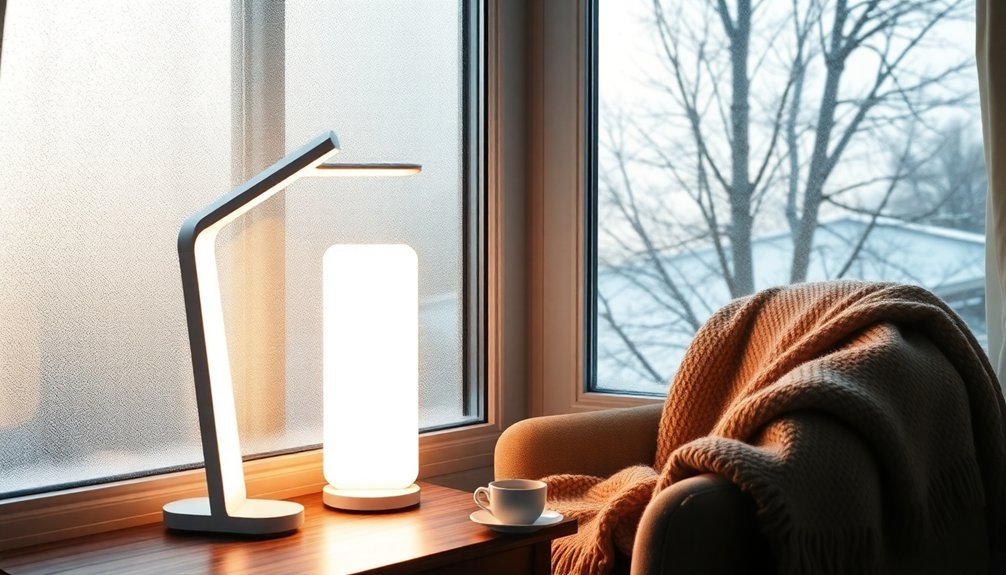
When exposed to bright therapeutic light, your brain initiates a cascade of biological responses that help regulate mood and sleep patterns. Your pineal gland reduces melatonin production when it detects bright light, while your brain simultaneously increases serotonin levels.
These changes are particularly effective when you receive light therapy in the morning, as it works with your natural circadian rhythm to create a more stable sleep-wake cycle.
The biological impact of light therapy affects your body in three key ways:
- Melatonin Regulation: Light that's 20 times brighter than indoor lighting suppresses your nighttime melatonin production, helping reset your seasonal biological clock.
- Serotonin Boost: Your brain's serotonin levels, which are typically lower during winter months, increase with regular light exposure, improving your mood and reducing depressive symptoms.
- Circadian Reset: Morning light exposure helps shift your biological rhythms earlier, counteracting the natural tendency for your body clock to drift later during winter months.
You'll typically notice improvements within days of starting treatment, but you'll need to maintain consistent sessions to prevent symptoms from returning when daylight hours shorten again.
Creating Effective Treatment Schedules
Creating an effective treatment schedule for seasonal affective disorder requires three key elements: consistent timing, proper duration, and preventive planning. You'll need to commit to 20-30 minutes of light therapy daily, ideally first thing in the morning, to maintain the most beneficial results.
To maximize your treatment's effectiveness, you should start your sessions before fall arrives, helping prevent symptoms before they begin. If you live in higher latitudes, you'll likely need a more robust treatment approach.
You can combine light therapy with other treatments like psychotherapy or medication, depending on your symptom severity and individual needs.
Your treatment schedule should also incorporate lifestyle changes that support your therapy. You'll want to maintain regular exercise routines, increase your natural sunlight exposure when possible, and focus on nutrient-rich foods to stabilize your mood.
Don't forget to discuss your long-term treatment plan with your healthcare provider, who can help you adjust your schedule based on your specific needs. They might recommend additional elements like vitamin D supplements or cognitive behavioral therapy to complement your light therapy sessions and create a thorough treatment approach.
Frequently Asked Questions
Can I Use Light Therapy While Taking Certain Medications or Supplements?
You shouldn't use light therapy while taking photosensitizing medications like antibiotics, antipsychotics, or cancer drugs. Check with your doctor first, as these medications can increase your risk of severe skin reactions.
Does Eye Color Affect How Well Light Therapy Works for SAD?
There's no proven link between your eye color and light therapy's effectiveness for SAD. While individual responses vary, research hasn't shown that eye color impacts how well you'll respond to light therapy treatment.
Should Light Therapy Sessions Be Split Into Multiple Shorter Intervals Throughout Day?
You shouldn't split light therapy sessions. Research shows one 30-minute morning session works best, while splitting sessions may disrupt your circadian rhythm and reduce effectiveness. Stick to a consistent morning routine for ideal results.
Can Traveling to Sunny Locations Replace the Need for Light Therapy?
No, you can't replace light therapy with sunny travel. While vacation sunshine may temporarily help your symptoms, you'll need consistent light therapy throughout winter months for effective, long-term SAD symptom management.
How Does Artificial Light Therapy Compare to Natural Sunlight Exposure Outdoors?
While both are effective, natural sunlight typically offers better results for SAD symptoms. You'll get added benefits from outdoor exposure like physical activity, but artificial therapy provides consistent treatment regardless of weather conditions.
In Summary
You'll need 30-minute light therapy sessions for winter SAD because that's the minimum time required for your brain to respond effectively to the treatment. Your circadian rhythm needs this consistent duration to reset properly and trigger the necessary biological changes. If you stick to daily 30-minute exposures, particularly in the morning, you'll help regulate your melatonin and serotonin levels for better mood management during winter months.

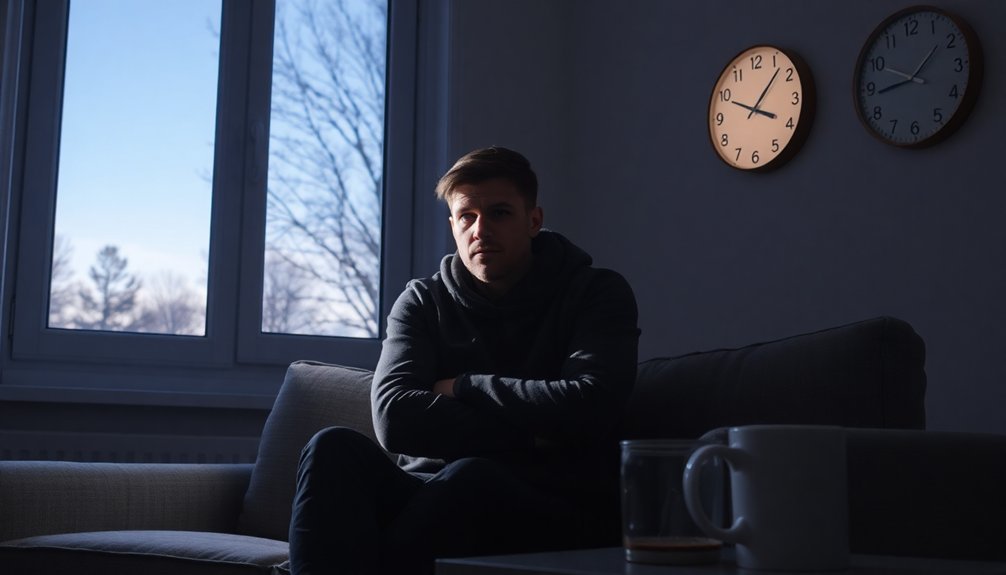



Leave a Reply